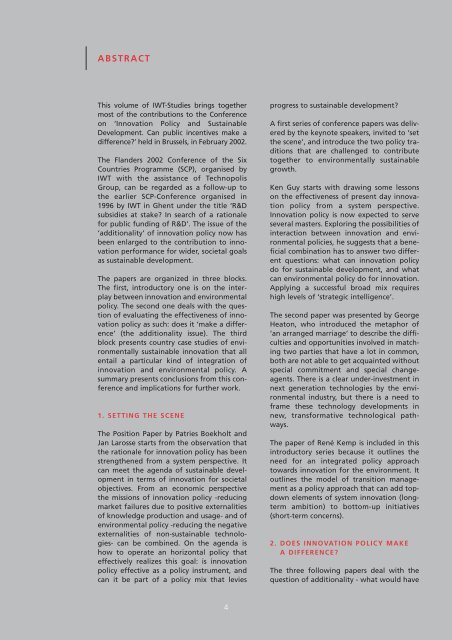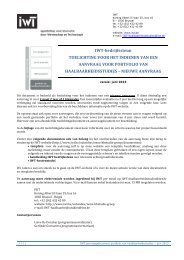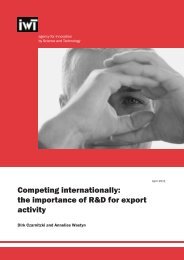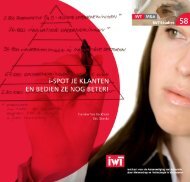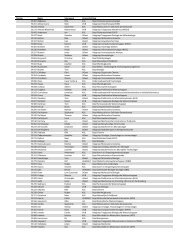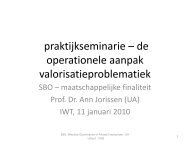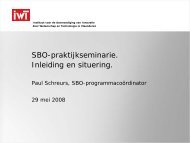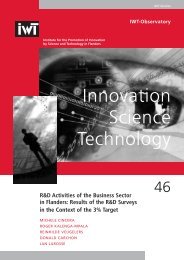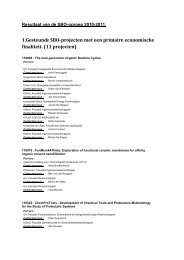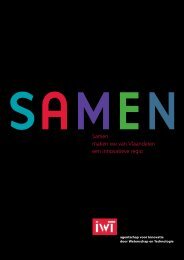40 Innovation Policy and Sustainable Development - IWT
40 Innovation Policy and Sustainable Development - IWT
40 Innovation Policy and Sustainable Development - IWT
You also want an ePaper? Increase the reach of your titles
YUMPU automatically turns print PDFs into web optimized ePapers that Google loves.
ABSTRACT<br />
This volume of <strong>IWT</strong>-Studies brings together<br />
most of the contributions to the Conference<br />
on ‘<strong>Innovation</strong> <strong>Policy</strong> <strong>and</strong> <strong>Sustainable</strong><br />
<strong>Development</strong>. Can public incentives make a<br />
difference’ held in Brussels, in February 2002.<br />
The Fl<strong>and</strong>ers 2002 Conference of the Six<br />
Countries Programme (SCP), organised by<br />
<strong>IWT</strong> with the assistance of Technopolis<br />
Group, can be regarded as a follow-up to<br />
the earlier SCP-Conference organised in<br />
1996 by <strong>IWT</strong> in Ghent under the title ‘R&D<br />
subsidies at stake In search of a rationale<br />
for public funding of R&D’. The issue of the<br />
‘additionality’ of innovation policy now has<br />
been enlarged to the contribution to innovation<br />
performance for wider, societal goals<br />
as sustainable development.<br />
The papers are organized in three blocks.<br />
The first, introductory one is on the interplay<br />
between innovation <strong>and</strong> environmental<br />
policy. The second one deals with the question<br />
of evaluating the effectiveness of innovation<br />
policy as such: does it ‘make a difference’<br />
(the additionality issue). The third<br />
block presents country case studies of environmentally<br />
sustainable innovation that all<br />
entail a particular kind of integration of<br />
innovation <strong>and</strong> environmental policy. A<br />
summary presents conclusions from this conference<br />
<strong>and</strong> implications for further work.<br />
1. SETTING THE SCENE<br />
The Position Paper by Patries Boekholt <strong>and</strong><br />
Jan Larosse starts from the observation that<br />
the rationale for innovation policy has been<br />
strengthened from a system perspective. It<br />
can meet the agenda of sustainable development<br />
in terms of innovation for societal<br />
objectives. From an economic perspective<br />
the missions of innovation policy -reducing<br />
market failures due to positive externalities<br />
of knowledge production <strong>and</strong> usage- <strong>and</strong> of<br />
environmental policy -reducing the negative<br />
externalities of non-sustainable technologies-<br />
can be combined. On the agenda is<br />
how to operate an horizontal policy that<br />
effectively realizes this goal: is innovation<br />
policy effective as a policy instrument, <strong>and</strong><br />
can it be part of a policy mix that levies<br />
progress to sustainable development<br />
A first series of conference papers was delivered<br />
by the keynote speakers, invited to ‘set<br />
the scene’, <strong>and</strong> introduce the two policy traditions<br />
that are challenged to contribute<br />
together to environmentally sustainable<br />
growth.<br />
Ken Guy starts with drawing some lessons<br />
on the effectiveness of present day innovation<br />
policy from a system perspective.<br />
<strong>Innovation</strong> policy is now expected to serve<br />
several masters. Exploring the possibilities of<br />
interaction between innovation <strong>and</strong> environmental<br />
policies, he suggests that a beneficial<br />
combination has to answer two different<br />
questions: what can innovation policy<br />
do for sustainable development, <strong>and</strong> what<br />
can environmental policy do for innovation.<br />
Applying a successful broad mix requires<br />
high levels of ‘strategic intelligence’.<br />
The second paper was presented by George<br />
Heaton, who introduced the metaphor of<br />
‘an arranged marriage’ to describe the difficulties<br />
<strong>and</strong> opportunities involved in matching<br />
two parties that have a lot in common,<br />
both are not able to get acquainted without<br />
special commitment <strong>and</strong> special changeagents.<br />
There is a clear under-investment in<br />
next generation technologies by the environmental<br />
industry, but there is a need to<br />
frame these technology developments in<br />
new, transformative technological pathways.<br />
The paper of René Kemp is included in this<br />
introductory series because it outlines the<br />
need for an integrated policy approach<br />
towards innovation for the environment. It<br />
outlines the model of transition management<br />
as a policy approach that can add topdown<br />
elements of system innovation (longterm<br />
ambition) to bottom-up initiatives<br />
(short-term concerns).<br />
2. DOES INNOVATION POLICY MAKE<br />
A DIFFERENCE<br />
The three following papers deal with the<br />
question of additionality - what would have<br />
4


